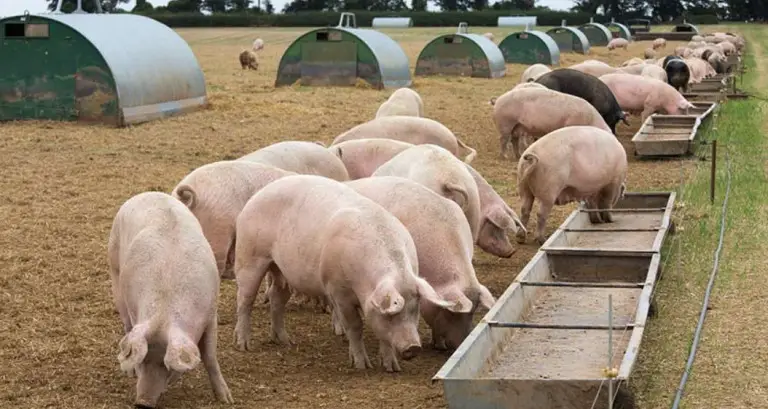No products in the cart.
Pig
What Do Pigs Eat? Do They Eat Anything & Everything?
Pigs have a simple stomach and a flexible digestive system, allowing them to eat a wide range of food. But what do pigs eat in the wild and captivated settings? Can they eat anything and everything as we assumed?
If you want to add this type of animal to your farm or are curious to know more about these omnivores, here is some important information on types of foods for pigs and their eating behavior.
*This post may have affiliate links, which means I may receive commissions if you choose to purchase through links I provide (at no extra cost to you). As an Amazon Associate I earn from qualifying purchases. Please read my disclaimer for additional details.
What Do Pigs Eat In The Wild?
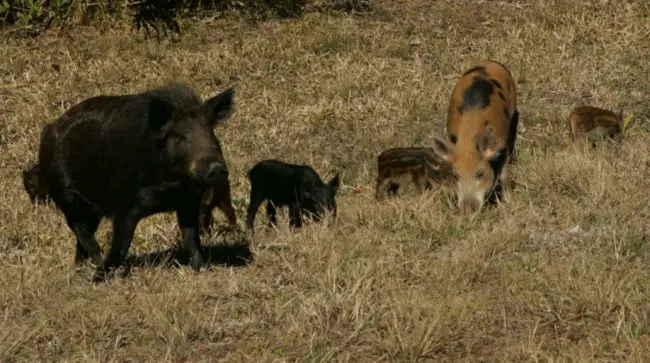
Pigs are omnivores, just like humans. Thus, they can eat almost all plants and animals. Vegetation, fruits, eggs, plant roots, and even dead animals are their favorite foods. Their digestive system is naturally designed to absorb a wide range of food.
This easy-going eating behavior of pigs allows them to adapt to all climate and area settings quickly as well as making them a great, profitable choice for farms of all sizes.
What Do Pigs Eat At Farms?
Unlike their wild cousins, domestic pigs (including meat pigs, farm pigs) mainly eat pig feed to reach their butcher weight quickly.
Pig feed for domestic pigs is a mixture of the following grains:
- Corn
- Soybean
- Grains
These grains are cost-effective, easy to find, and easy to digest, contain high carbohydrates, calcium, and have little fiber. They help support the healthy growth of pigs and reduce their health risks.
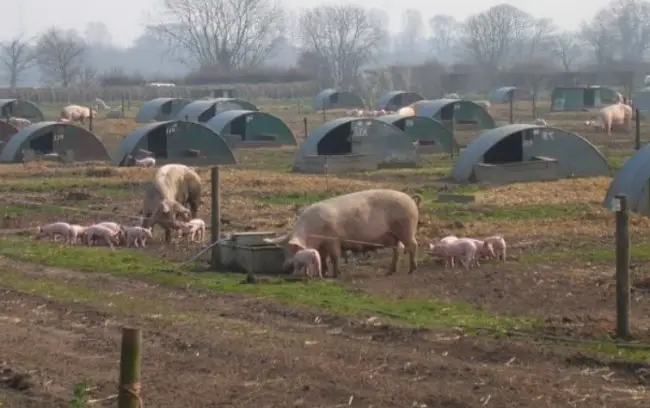
Apart from that, pigs living on a farm also need the following foods and supplements to maintain good health:
Vitamins & supplements
Large-scaled farms often add vitamins and minerals to pig feed to add up their nutritional deficiencies. These supplements also help improve their metabolic function.
There are 10 important minerals for pigs, including sodium, chloride, zinc, iron, iodine, selenium, copper, manganese, chromium, and cobalt. You can adjust the daily mineral intake for your livestock based on their situations.
For instance, you can mix more iron supplements in pig feed to prevent anemia, which is a common issue in piglets who often drink milk. Likewise, zinc is a highly advisable mineral that helps enhance pigs’ skin health and reproductive functions.
Commercial feed (ready-made pig feed)
In many forms and mixes, this pig feed is specially made to meet the nutritional demands of pigs in some stages of their life. You can get this feed at any feed store or via livestock feed manufacturers. Besides the common feed type, there are also medicated pig feed with pre-mixed vitamins, minerals, antibiotics, and probiotics.
Antibiotics
In some medicated pig feeds, there are also antibiotics to help prevent the widespread of some diseases. You can often see this supplement on large-scaled, intensive farms, not on small-scaled ones or homesteads.
Water
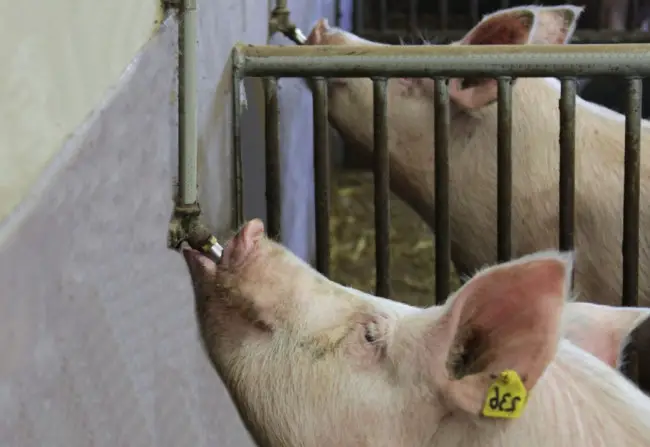
Over half of a pig’s body weight is water, and water plays a vital part in a pig’s feed intake, overall health, and reproductive functions. Thus, you should always check and maintain a clean, accessible supply of high-quality water with a moderate level of minerals or sulfates.
A regular pig drinks from 2 to 3 kilograms of water per kilogram of dry feed. In its lactating period, it needs a higher daily water intake. To ensure your pigs get enough water, you should provide a large water bowl or nipple waterer for every 10 pigs on your farm.
Pigs Diet Differs Among Breeds, Purposes & Ages
Not all domestic pigs have the same diet plan. In other words, the differences in the diet of domestic pigs result from your raising purposes and pigs’ lifestyle and their stages of life.
For example, pigs with all-day access to pasture need a smaller daily grain intake. Sows that are lactating or gestating need more water, nutrients, and lysine supplement – additionally, meat pigs and farm pigs than pet pigs.
Breeds affect pigs’ diet
It is undeniable that the breed of a pig plays a vital part in their diet.
For example, the daily intake and amount of feed for meat pigs such as Red Wattle Pig is not as for pet pigs. Similarly, there are some differences in the daily diet of a Vietnamese Pot Belly pig with that of a Large White pig.
Traditional pig breeds like Gloucester Old Spot pigs are better forages than conventional ones. Since they gain weight gradually and eat mainly pasture, there is no need to feed them special pig feeds. They are also better at adapting to extreme climates or weather compared to the modern commercial ones.
The purpose of raising pigs affect their diet
Apart from their breed, your purpose in raising pigs is to determine what and how to feed them.
The pig raising purpose can be divided into 4 standard groups:
- Pigs reared for meat: These pigs follow a diet program that aligns with each stage of their life, including weaning feed, grower, and finishing feed.
- Pigs for breeding sows: At their breeding age, sows should be fed with pig pellets high in nutrition and contain low protein levels.
- Pigs that are kept as pets (pet pigs, micro-pigs, Vietnamese Pot Belly pigs): Like breeding sows, these pigs are not required to gain weight quickly as meat pigs. Thus, they should be fed with pig pellets.
- Pigs for competitions or farming shows: These show pigs should be fed specialist pig feeds. Please notice that different breeds have different feeding methods.
Diets for Piglets, Growers & Finisher pigs
The pig’s age also determines what it can eat. You can divide pigs by their ages into three groups – weaners, growers, and finisher pigs.
1. Weaners
Although baby pigs can eat solid ingredients, 1 month after birth, their digestive system doesn’t have the required enzyme for digesting grains like corn. Thus, when they are 3 weeks old, they can start solid feeds along with their mother’s milk until they are 10-12 weeks old. Pigs at this stage of life are called weaners.
Weaners are fed with specific feeds that meet their nutritional demands. This feed is called weaner feed, piglet feed, starter feed, or other similar names. These feeds often contain probiotics and enzyme supplements to boost their digestive system and gut flora.
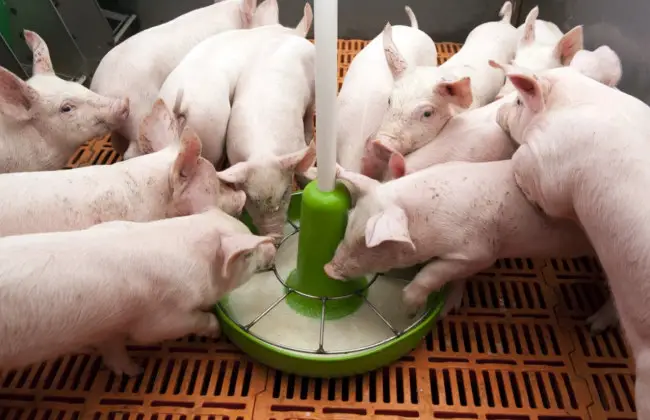
The most common types of feed for weaners include:
- Creep feed: This feed mainly contains milk protein and can be used as a milk replacement.
- Pre-starter feed: It is a mixture of milk, protein, and grains. This feed can be used for weaners until they reach 15 pounds of weight.
- Starter or weaning feed: This feed can be used after weaners stop eating mother’s milk. It contains ingredients like sorghum, peanuts, soybean, and sunflower seeds. Besides providing weaners protein, fat, and fiber, this feed is also easy to digest. You can feed them this feed until they are 45 pounds.
2. Grower & Finishing feed
When pigs have finished their weaning period, they will be divided into two groups based on their weights:
- Growing pigs: weigh from 40 to 125 pounds. These pigs are fed grower.
- Finishing pigs: weigh from 125 to 230 pounds. These pigs are fed finishing feed.
- Grower
When pigs are 12 weeks old, you can start feeding them grower – a special type of food that helps pigs gain weight in a short time.
Grower provides pigs with protein and fat and lysine supplement for their weight and muscle growth. Thus, you might find some protein-rich ingredients in grower like sorghum or soybean. In some grower products, there might be protein supplements.
On average, pigs can gain from 1.5 to 1.7 pounds per day until they reach 110 pounds. To reach this goal, they have to eat around 5% of their body weight in their first years of life (around 6-8 pounds of feed per day). When getting older, they can gain 2 pounds per day.
Why can’t commercial feed be used as a grower? Although this feed is affordable, they do not contain enough nutrients for the optimum weight gain in pigs.
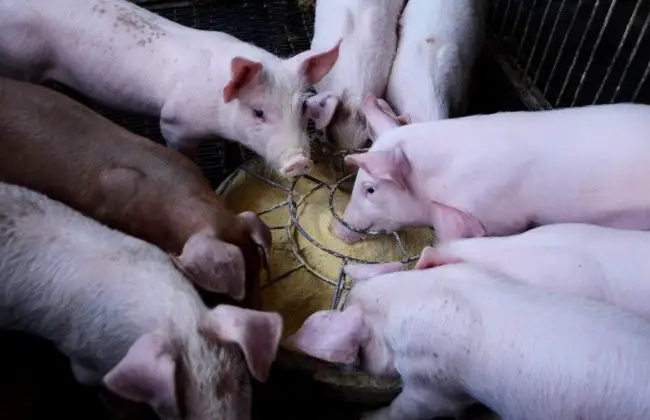
- Finishing feed
As pigs get older and gain weight, they don’t need as much protein as their peak growth stage. Thus, you can provide them finishing feed with higher protein content and less mineral content than the grower.
What Should You Not Feed Pigs?
Besides swine-friendly foods, there are some toxic foods that you should never feed your animals:
- Moldy, slimy, rotten foods.
- Raw meat: as it can transfer some severe diseases in swine like the foot and mouth.
- Raw egg: as it can interfere with the swine absorption of biotin.
- Foods with high levels of salt and sugar: never provide pigs foods or feeds with high sodium content like cat foods or dogs foods, since each animal has a different sodium demand. Sugary foods like pastries, sweet bread, candies, or fresh fruits with high sugar are also a big no-no to these omnivores as these are all high in sugar.
- Wild mushrooms: because these plants contain toxins that can lead to poisoning or even death to pigs.
- Unripe tomatoes, raw potatoes or raw sweet potatoes, celery or celery root, parsnips, onions, parsley, rhubarb, and avocados.
- The leaves, roots, vines, and seeds of tomato, broccoli, turnips, cabbage.
- Food leftovers contain meat or have a connection with any kind of meat, like chicken bones.
Notice: Toxic things to pigs!
- Mycotoxins: These natural toxins are caused by mold in contaminated feed on food bins. To avoid this poisoning, you should keep their food bins dry and clean. If your animals don’t like a type of feed, stop feeding them to prevent waste.
- Alcohol: You should never feed alcoholic beverages to pigs. The fermentation of old grains in pig feed can also cause alcohol poisoning.
- Salt: Some wet rations contain a high level of salt, leading to dehydration in pigs. If you think your pigs suffer from salt poisoning, don’t provide them too much water at a time since it can make the poisoning worse.
- Coal tar: Pigs like the taste of coal tar, like paint or disinfectants. This toxic thing can damage their liver or lead them to death.
- Medication: To avoid medication poisoning in pigs, offer them only pig medicines under the allowance of your veterinarian.
- Plants: Some plants that are highly poisonous to pigs are Bracken, ragwort, cocklebur, henbane, ivy, hemlock, acorns, foxglove, deadly nightshade, rhododendron, elder, and laburnum. Jimsonweed – also known as Prickly burr, Hell’s Bells, Jamestown Weed, Devil’s Weed, Stinkweed, Devil’s Trumpet, or Devil’s Cucumber – is also poisonous to them.
Notice:
The sign of poisoning varies based on what kinds of toxic things pigs have eaten. Call your veterinarian immediately if you notice some most common symptoms, namely shallow, elevated or weakened heart pulse, irregular breathing, twitching, dilated pupil, low body temperature, depression, abnormal urination, diarrhea, staggering.
How Much Do Pigs Eat Daily?
Nutrition and water are the two most essential factors in profitable pork production. Thus, you should always allow free access to pig feed and clean water.
Besides, you should also adjust the appropriate lysine intake based on their life stages. Lysine plays a crucial part in the muscle development of pigs’ diet. The amount of protein to form muscle in pigs relies on the amount of lysine in their feed. Thus, without sufficient lysine intake, amino acids cannot combine to develop muscles.
For pigs from 50 to 150 pounds of weight, you should provide them a daily feed containing 1.2 – 1.3% lysine. From 150 pounds until show day, this lysine intake should be reduced to 0.9 – 1% for proper development.
The following guideline table indicates the recommended daily feed requirements for pigs based on their body weight.
| Weight (pounds) | Amount of required feed
(pound/day) |
Metabolizable Energy
(ME, Mcal) |
Lysine requirement
(gram/day) |
| 150 | 2.1 | 3.21 | 0.9 |
| 160 | 2.2 | 3.34 | 0.9 |
| 170 | 2.3 | 3.46 | 0.9 |
| 180 | 2.4 | 3.58 | 1.0 |
| 190 | 2.5 | 3.70 | 1.0 |
| 200 | 2.5 | 3.81 | 1.1 |
| 210 | 2.6 | 3.93 | 1.1 |
| 220 | 2.7 | 4.04 | 1.1 |
| 230 | 2.8 | 4.15 | 1.2 |
| 240 | 2.8 | 4.26 | 1.2 |
| 250 | 2.9 | 4.36 | 1.3 |
| 260 | 3.0 | 4.46 | 1.3 |
| 270 | 3.0 | 4.57 | 1.3 |
| 280 | 3.1 | 4.67 | 1.4 |
| 290 | 3.2 | 4.77 | 1.4 |
Source: The Ohio State University
- 1 pound of corn = 1.55 Mcal, ME
- 1 pound of SBM = 1.53 Mcal, ME
Please notice that this table is for no weight gain. Thus, you can gradually increase their amount of feed to grow your pigs little by little.
How To Feed Pigs?
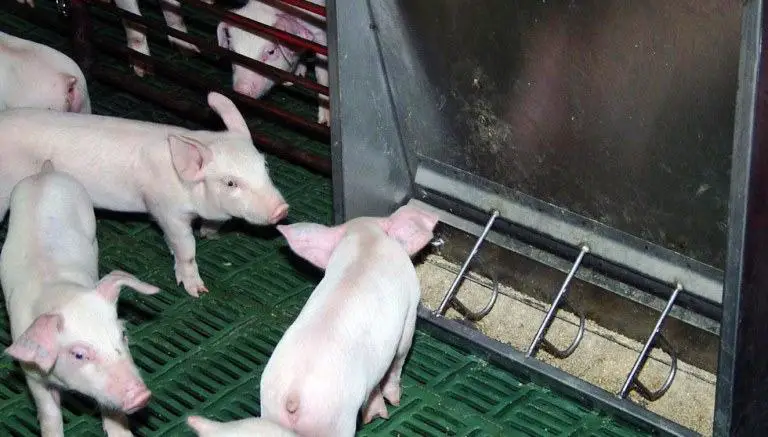
You should feed your pigs twice per day in a pig feeder, feeding trough or via a feeding system.
The amount of feed should be well-aligned with pigs’ age, breed, and access to other foodstuffs. Each commercial feed often comes with detailed instructions on how and how much you can feed your animals. If there is no instruction attached to the feed product, you should ask for advice from the feed store.
Additionally, there are some general rules you should know when feeding these omnivores:
- A pig needs to consume one pound of feed for each month of age, with a maximum of 6 pounds per day. Except you are feeding lactating sows, don’t feed them more than this limitation. Overfeeding can add up a remarkable amount of your feeding cost and leads to obesity in pigs.
- Make sure that your pigs eat up all the feed within 20 – 30 minutes. If there are leftovers, reduce their feed intake until there is no excessive fee left. After that, you can try to increase their feed again slowly.
- Easy accessibility to other natural foodstuffs like fresh fruits, dense grass, pasture, hay, silage can help you reduce your feed costs.
- Fruits and vegetables shouldn’t become a central part of their daily diet. Instead, keep the ratio of these foods to pig feed to 1:4.
- Never feed pigs silage with mold since the harmful bacteria like Listeria in this silage can cause serious health issues to pigs. It can eventually lead to abortion in pregnant sows.
- Store foods in a dry and safe location. Never feed old, wet, or moldy foods to pigs.
- What swine eat can affect their meat’s tasting. For example, the pork of pigs that often consume acorns and apples have a sweeter taste. Pork from swine fed with this diet is also called “specialist pork” sold at a higher price than conventional pork.
- Swill from cafeteria waste or family food waste that comes into contact with other meats can be used as additional swine foodstuff. You should study your country’s laws and local regulations before feeding swill to them.
Frequently Asked Questions
1. Do pigs eat their own poop?
Some pigs like eating their poops but not all of them have this eating preference. Pigs have their likes and dislikes, just like humans or other animals. So, whether pigs eat their poops depends on their taste.
2. Do pigs eat egg shells?
Pigs can eat egg shells since this food is a good source of calcium for pigs. Make sure that you dry and break them into small pieces before feeding your pigs.
3. Can pigs eat banana peels?
Yes, pigs can eat bananas. But since each of them has a different taste of food, you should notice if they prefer eating banana or banana peels.
4. Can pigs eat tomatoes?
Pigs can eat tomatoes. However, you should not feed them unripe ones or the leaves, roots, vines, and seeds of this juicy vegetable since these feeds can cause poisoning in pigs. Besides, tomatoes should not be the main part of pigs’ daily diet.
5. Can pigs eat uncooked oatmeal?
Oatmeal is tasty food for pigs of all life stages and farming methods. You can provide them raw or cooked, hulled or unhulled oatmeal in their daily feed.
6. Can pigs eat rice?
Feeding pigs with a moderate amount of rice in their nursery stage can help improve their physical health. However, make sure that you feed them with cooked rice so that they can digest it easily.
7. Do pigs eat carrots?
Pigs can eat carrots, but they prefer boiled ones to raw ones. So if feeding them raw carrots, you should cut these vegetables into small pieces.
8. Do pigs eat grass?
Pigs can eat grass since their digestive system has enzymes to absorb cellulose – a complex carbohydrate in plants like grass. However, they can lack nutrients for meat production or reproduction if you only solely feed them grass.
9. Do pigs eat humans?
If pigs are given a chance to attack humans, they can eat humans for their meals.
10. What meat do pigs eat?
As pigs are omnivores, they can consume various types of meat. But you should only provide cooked meat to your domestic pigs to avoid any possible health risks.
11. Why do pigs eat dirt?
Sometimes you can see your pigs eating dirt, sand, and mud. This behavior is normal for all pigs. Dirt contains many nutrients like trace minerals, unique microflora, and organic compounds that are good for the physical growth of pigs.
12. What do you pigs eat before butchering?
Some farmers try to feed pigs 9-10 hours before slaughter. While this action can gain live animal weight and reduce the mortality of pigs on the way to the slaughterhouse, it can’t help increase carcass weights. Therefore, you should not feed pigs anything before butchering to save your feeding cost and not affect pork safety and quality.
Final Words
As you can see, there are many factors you should consider when feeding pigs, including their age and your purpose in raising them. After knowing what pigs eat and what they can’t, I hope you can make a well-balanced diet plan for your omnivores for maximum profit, minimal cost, and long-term sustainability.
